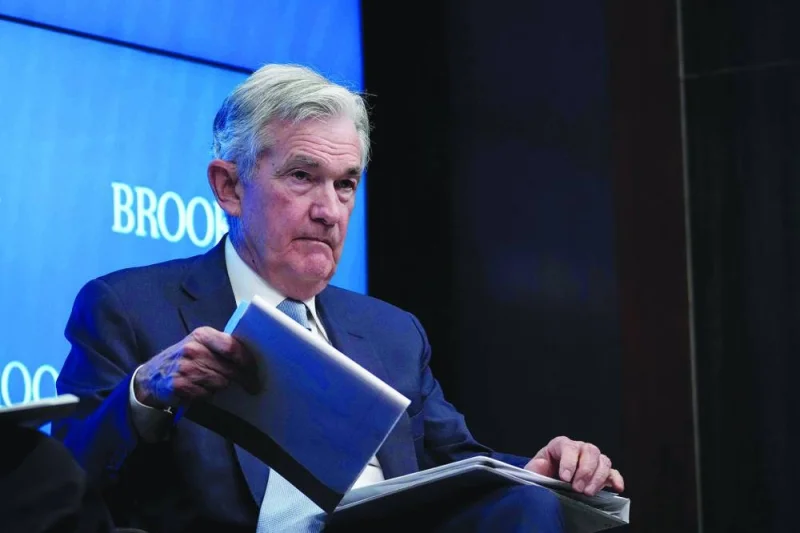A rally in US stocks and bonds powered ahead after a speech by Federal Reserve Chairman Jerome Powell on Wednesday, but some investors believe a looming recession could cap gains in both asset classes.
Though asset prices have been battered by the Fed’s rate rises this year, momentum has been on the side of the bulls in recent weeks.
The S&P 500 has soared nearly 14% from its October low while yields on the 10-year benchmark Treasury, which move inversely to prices, are down at around 3.6%, from a 15-year high of 4.3% earlier this year.
The immediate reaction to Powell’s speech on Wednesday showcased investors’ recently optimistic mood.
The S&P 500 soared more than 3% after Powell said the Fed could scale back the pace of its rate increases as soon as December, although he warned there was little clarity on how high rates will ultimately need to rise as the central bank fights the worst outbreak of inflation in decades.
Still, some market participants believe the weeks-long upswing in stocks and bonds is bound to fizzle, a fate that has met a handful of other rebounds this year.
The S&P 500 is down 14.4% year-to-date.
Upcoming employment and inflation reports — due on December 2 and December 13, respectively — could become near-term stumbling blocks if they fail to show that the rate rises the central bank has already delivered this year have sufficiently cooled the economy.
US consumer prices rose less than expected in October, supporting the view that inflation was ebbing.
Further ahead, some of Wall Street’s biggest banks are now forecasting that the Fed’s monetary policy tightening will bring on a recession next year.
The inversion of the US Treasury yield curve — a signal that has preceded past downturns — has lent weight to recession predictions.
Yields on two-year Treasuries recently exceeded those on 10-year Treasuries by their biggest margin since the dot com bubble.
“Our view is that this is not an enduring rally,” said Jake Jolly, senior investment strategist at BNY Mellon. “The odds are there’s going to be a recession next year, and that’s going to pressure risk assets like equities.”
Citi’s analysts wrote that the rise in risk asset prices on Wednesday was due to “hawkish expectations that had built up ahead of Powell’s remarks, the assurance of a slowdown to a 50bp rate hike pace, and the absence of a clear escalation of the hawkish message delivered at the early November FOMC meeting.”
Their takeaway: Powell is shifting his focus to non-shelter service inflation, which will be more difficult to slow, “given still very-tight labour markets.” On Wednesday, Powell noted that key price measures for services remain high.
Data released earlier in the day showed there were still about 1.7 job openings for each unemployed person.
“Powell seemed to come today and express that they are confident that the brakes are working,” said Jake Schumeier, a portfolio manager at Harbor Capital Advisors, referring to the Fed’s spate of jumbo 75 basis point increases aimed at slowing the economy.
Over the longer term, however, “the market seems positioned for a slowdown, so that will limit the upside once we get past seasonal trends at the end of the year,” he said.
Among the banks predicting a downturn is Bank of America, whose analysts see a broadly flat S&P 500 as markets deal with “recession shock.”
BlackRock Investment Institute said on Wednesday that while a recession is likely, “equity valuations don’t yet reflect the damage ahead.” They are also underweight long-dated government bonds, betting that central banks are unlikely to stop cutting rates in a downturn if inflation stays high.
To what degree economic worries impact the market’s near-term bullish sentiment remains to be seen.
The S&P 500 on Wednesday traded above its 200-day moving average for the first time since April, a move that some chart-watching investors view as a sign of short-term equity strength.
In options markets, traders appear more preoccupied with not missing out on more gains in stocks than guarding against future declines.
The one-month moving average of daily trading in bearish put contracts against bullish calls on the S&P 500 index-tracking SPDR S&P 500 ETF Trust’s options is at its lowest since January 2022, according to Trade Alert data.
Business
Markets sigh with relief after Powell speech, but more turbulence likely ahead amid concerns over recession

US Federal Reserve Chair Jerome Powell speaks at the Brookings Institution on Wednesday in Washington, DC. The S&P 500 soared more than 3% after Powell said the Fed could scale back the pace of its rate increases as soon as December, although he warned there was little clarity on how high rates will ultimately need to rise as the central bank fights the worst outbreak of inflation in decades.


